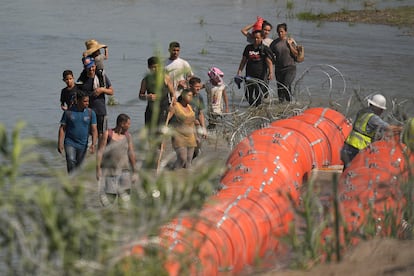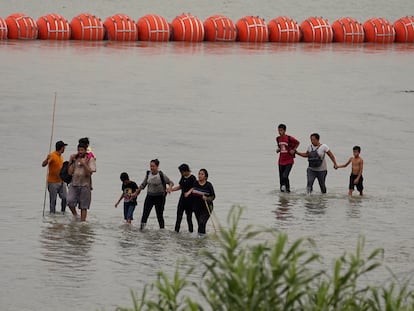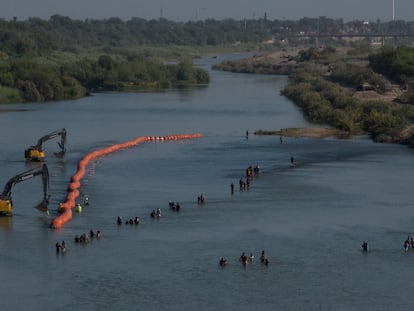A judge orders Texas to move a floating barrier used to deter migrants to the bank of the Rio Grande
The decision by U.S. District Judge David Ezra is a victory for President Joe Biden’s administration, which sued after Texas put the wrecking ball-sized buoys on the water in early July as part of a sprawling border security mission known as Operation Lone Star

A federal judge on Wednesday ordered Texas to move a large floating barrier to the bank of the Rio Grande after protests from the the U.S. and Mexican governments over Republican Gov. Greg Abbott’s latest tactic to stop migrants from crossing America’s southern border.
The decision by U.S. District Judge David Ezra is a victory for President Joe Biden’s administration, which sued after Texas put the wrecking ball-sized buoys on the water in early July as part of a sprawling border security mission known as Operation Lone Star. The judge said the state must move the barrier by Sept. 15.
The barrier threatens provisions of a treaty between U.S. and Mexico, wrote Ezra, who also cast doubt on its effectiveness.
“The State of Texas did not present any credible evidence that the buoy barrier as installed has significantly curtailed illegal immigration across the Rio Grande River,” Ezra wrote.
Abbott said Texas would appeal.
“Today’s court decision merely prolongs President Biden’s willful refusal to acknowledge that Texas is rightfully stepping up to do the job that he should have been doing all along,” Abbott said.
Texas used dozens of bright orange buoys to created a barrier longer than a soccer field on a stretch of river where migrants often try crossing from Mexico. Texas also has installed razor wire and steel fencing on the border, and has empowered armed officers to arrest migrants on trespassing charges.
The buoys brought a swift legal challenge from the U.S. Justice Department, which accused Texas putting a barrier on the international boundary without permission. The Biden administration also said the water barrier raised humanitarian and environmental concerns.
Texas installed the barrier near the border town of Eagle Pass and put anchors in the riverbed. Eagle Pass is part of a Border Patrol sector that has seen the second-highest number of migrant crossings this fiscal year with about 270,000 encounters — though that is lower than it was at this time last year.
The Biden administration has said illegal border crossings declined after new immigration rules took effect in May as pandemic-related asylum restrictions expired.
Like other pieces of Abbott’s multibillion-dollar border mission known as Operation Lone Star, the buoys pick up where former President Donald Trump left off. Plans for the same water barrier were in the pipeline in 2020, according to Mark Morgan, who at the time was the acting commissioner of U.S. Customs and Border Protection.
Morgan said the plans were scrapped after Biden took office. He called the barrier a “water wall” and said it was intended to be used as a stopgap in sections of the border where fences were not yet built or were impractical.
Sign up for our weekly newsletter to get more English-language news coverage from EL PAÍS USA Edition
Tu suscripción se está usando en otro dispositivo
¿Quieres añadir otro usuario a tu suscripción?
Si continúas leyendo en este dispositivo, no se podrá leer en el otro.
FlechaTu suscripción se está usando en otro dispositivo y solo puedes acceder a EL PAÍS desde un dispositivo a la vez.
Si quieres compartir tu cuenta, cambia tu suscripción a la modalidad Premium, así podrás añadir otro usuario. Cada uno accederá con su propia cuenta de email, lo que os permitirá personalizar vuestra experiencia en EL PAÍS.
¿Tienes una suscripción de empresa? Accede aquí para contratar más cuentas.
En el caso de no saber quién está usando tu cuenta, te recomendamos cambiar tu contraseña aquí.
Si decides continuar compartiendo tu cuenta, este mensaje se mostrará en tu dispositivo y en el de la otra persona que está usando tu cuenta de forma indefinida, afectando a tu experiencia de lectura. Puedes consultar aquí los términos y condiciones de la suscripción digital.
More information
Archived In
Últimas noticias
More than 40 Democratic lawmakers urge Trump in a letter to stop his ‘attempts to undermine democracy in Brazil’
The journal ‘Science’ criticizes Trump’s anti-renewable energy policy: ‘The US is failing to benefit from its own innovations’
Cubans hope for a miracle as dengue and chikungunya spread
The long shadow of the father figure in the films of Rob Reiner
Most viewed
- Christian Louboutin: ‘Young people don’t want to be like their parents. And if their parents wear sneakers, they’re going to look for something else’
- Cartels in Mexico take a leap forward with narco-drones: ‘It is criminal groups that are leading the innovation race’
- ‘El Limones’ and the growing union disguise of Mexican organized crime
- Liset Menéndez de la Prida, neuroscientist: ‘It’s not normal to constantly seek pleasure; it’s important to be bored, to be calm’
- The low-cost creative revolution: How technology is making art accessible to everyone










































